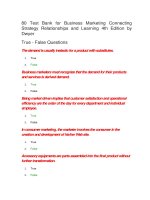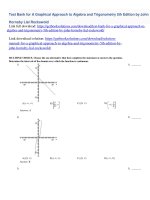Test bank for the human body in health and illness 5th edition by barbara herlihy download
Bạn đang xem bản rút gọn của tài liệu. Xem và tải ngay bản đầy đủ của tài liệu tại đây (585.36 KB, 73 trang )
Chapter 8: Skeletal System
Test Bank
MULTIPLE CHOICE
1.
The humerus
a.
is located in the arm.
b.
is distal to the radius and ulna.
c.
articulates with the clavicle at the
acromioclavicular joint.
d.
is a bone of the axial skeleton.
ANS: A
2.
The humerus
a.
contains the olecranon process.
b.
articulates distally with the ulna.
c.
forms a ball-and-socket joint where the
olecranon process articulates with the
olecranon fossa.
d.
articulates with the scapula at the
sternomanubrial joint.
ANS: B
3.
The maxilla
a.
is the cheekbone.
b.
is a cranial bone.
c.
contains the upper teeth.
d.
articulates with the temporal bone at the TMJ.
ANS: C
4.
Which bone is found in the skull but not in the cranium?
a.
Occipital
b.
Parietal
c.
Sphenoid
d.
Mandible
ANS: D
5.
Which bone is found in the skull but is not a facial bone?
a.
Mandible
b.
Maxilla
c.
Occipital
d.
Zygomatic
ANS: C
6.
The zygomatic bone
a.
is a cranial bone.
b.
articulates with the mandible.
c.
holds the upper teeth.
d.
is called the cheekbone.
ANS: D
7.
Which of the following is most descriptive of the atlas and the axis?
a.
Carpal
b.
Vertebral
c.
Coxal
d.
Cranial
ANS: B
8.
The occipital bone
a.
is a facial bone.
b.
contains the foramen magnum.
c.
is the cheekbone.
d.
articulates with the frontal bone at the coronal
suture.
ANS: B
9.
Which of the following word(s) is (are) related to the ribs?
a.
Acetabulum
b.
True, false, and floating
c.
Supination and pronation
d.
Fontanels
ANS: B
10.
Fontanels
a.
are present in fetal and infant skulls.
b.
allow expansion of the infant skull during
growth.
c.
eventually fuse or seal.
d.
involve all of the above.
ANS: D
11.
Which bone is described by the following: leg, shin, and medial
malleolus?
a.
Fibula
b.
Tibia
c.
Talus
d.
Femur
ANS: B
12.
Which bone is distal to the acetabulum and proximal to the patella?
a.
Femur
b.
Tibia
c.
Fibula
d.
Calcaneus
ANS: A
13.
Which bone is distal to the femur and proximal to the tibia?
a.
Fibula
b.
Patella
c.
Talus
d.
Coxal bone
ANS: B
14.
Which bone is formed by the ischium, ilium, and pubis?
a.
Sacrum
b.
Cranium
c.
Coxal bone
d.
Breastbone
ANS: C
15.
Which of the following is not a bone of the vertebral column?
a.
Atlas
b.
Sacrum
c.
Coccyx
d.
Coxal bone
ANS: D
16.
Which bones form the palm of the hand?
a.
Tarsals
b.
Phalanges
c.
Metacarpals
d.
Metatarsals
ANS: C
17.
Which bones are distal to the radius and ulna and proximal to the
metacarpals?
a.
Pollux
b.
Carpals
c.
Tarsals
d.
Hallux
ANS: B
18.
a.
The humerus is a
bone of the axial skeleton.
b.
short bone.
c.
bone of the upper limbs.
d.
bone found only in the fetal skeleton.
ANS: C
19.
Which of the following is located at the ends of a long bone?
a.
Diaphysis
b.
Periosteum
c.
Epiphysis
d.
Medullary cavity
ANS: C
20.
Cancellous refers to a(n)
a.
irregular bone.
b.
cartilage.
c.
spongy bone.
d.
osteon.
ANS: C
21.
a.
Which structure is the site of attachment for tendons?
Endosteum
b.
Articular cartilage
c.
Periosteum
d.
Osteon
ANS: C
22.
Osteons are found primarily
a.
within the medullary cavity.
b.
in the diaphysis.
c.
on the outer surface of the articular cartilage.
d.
within the epiphyseal disc.
ANS: B
23.
The palatine process of this facial bone forms which anterior part
of the hard palate?
a.
Mandible
b.
Zygomatic
c.
Maxilla
d.
Sphenoid
ANS: C
24.
The coronal suture forms an immovable joint between the parietal
bones and which bone?
a.
Occipital
b.
Frontal
c.
Temporal
d.
Sphenoid
ANS: B
25.
A foramen and meatus are
a.
short bones.
b.
curvatures.
c.
openings.
d.
joints.
ANS: C
26.
Which structure refers to the shaft of a long bone?
a.
Diaphysis
b.
Epiphysis
c.
Periosteum
d.
Bursa
ANS: A
27.
Which word(s) best reflect(s) the function of the epiphyseal disc?
a.
Blood cell formation
b.
Phagocytosis
c.
Secretion of synovial fluid
d.
Longitudinal growth
ANS: D
28.
Which of the following bones is not located in the lower limbs?
a.
Femur
b.
Tibia
c.
Ulna
d.
Tarsal
ANS: C
29.
Cervical, thoracic, lumbar, sacral, and coccygeal refer to
a.
vertebrae.
b.
long bones.
c.
spinal curves.
d.
phalanges.
ANS: A
30.
At which joint do the humerus and ulna meet?
a.
Hip
b.
Elbow
c.
Knee
d.
Wrist
ANS: B
31.
At which joint do the femur and tibia meet?
a.
Hip
b.
Knee
c.
Ankle
d.
Elbow
ANS: B
32.
At which joint do the femur and tibia meet?
a.
Tibiofemoral
b.
Proximal tibiofibular
c.
Distal tibiofibular
d.
Sacroiliac
ANS: A
33.
At which joint do the femur and coxal bone meet?
a.
Hip
b.
Knee
c.
Ankle
d.
Wrist
ANS: A
34.
At which joint do the scapula and humerus meet?
a.
Hip
b.
Wrist
c.
Shoulder
d.
Elbow
ANS: C
35.
At which joint do the scapula and arm bone meet?
a.
Humeroulnar
b.
Radiocarpal
c.
Glenohumeral
d.
Sternoclavicular
ANS: C
36.
Injury to the epiphyseal disc of the tibia may
a.
stunt the growth of the injured leg.
b.
stimulate the bone to become cancerous.
c.
inhibit blood cell formation.
d.
cause arthritis.
ANS: A
37.
Which bone structure is most concerned with hemopoiesis?
a.
Diaphysis
b.
Bone marrow









